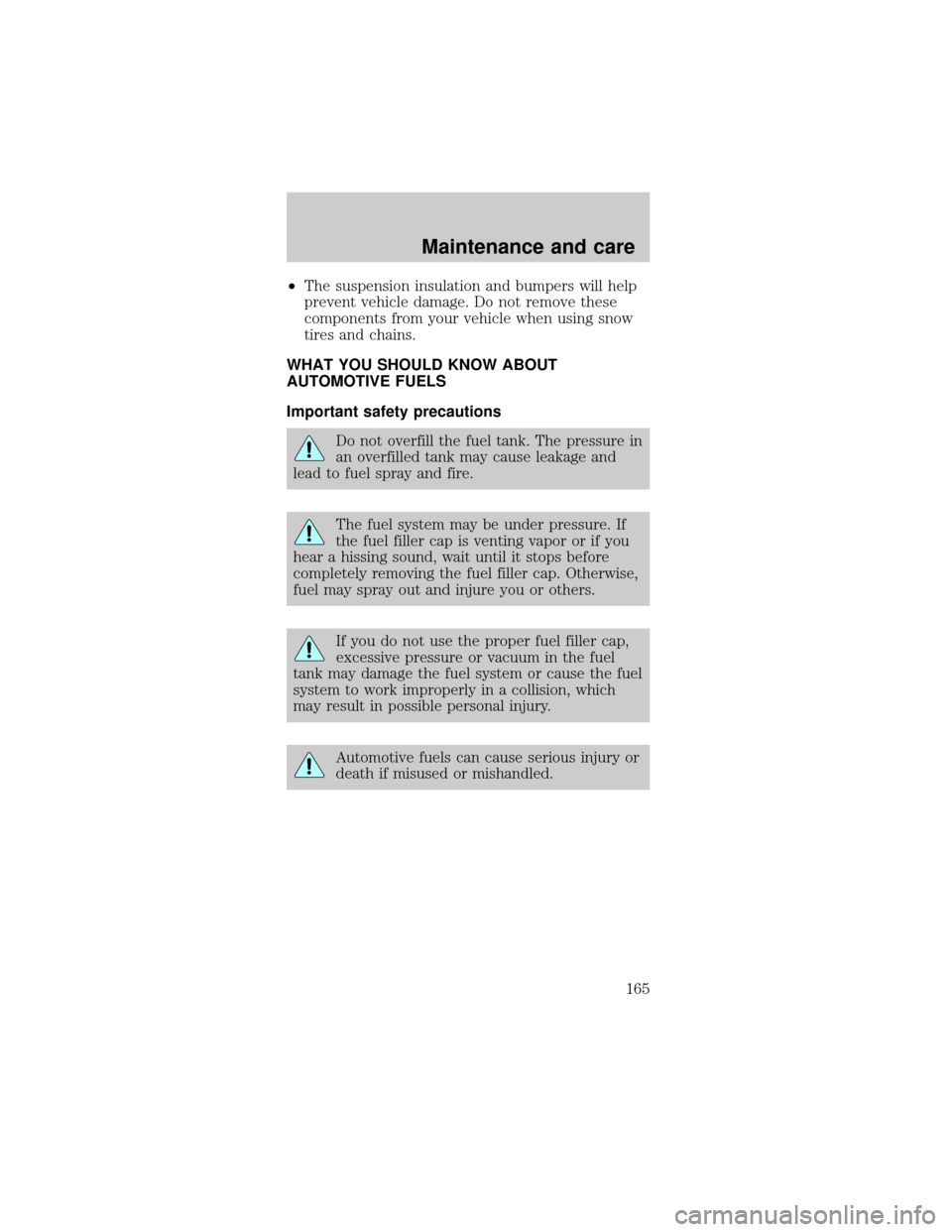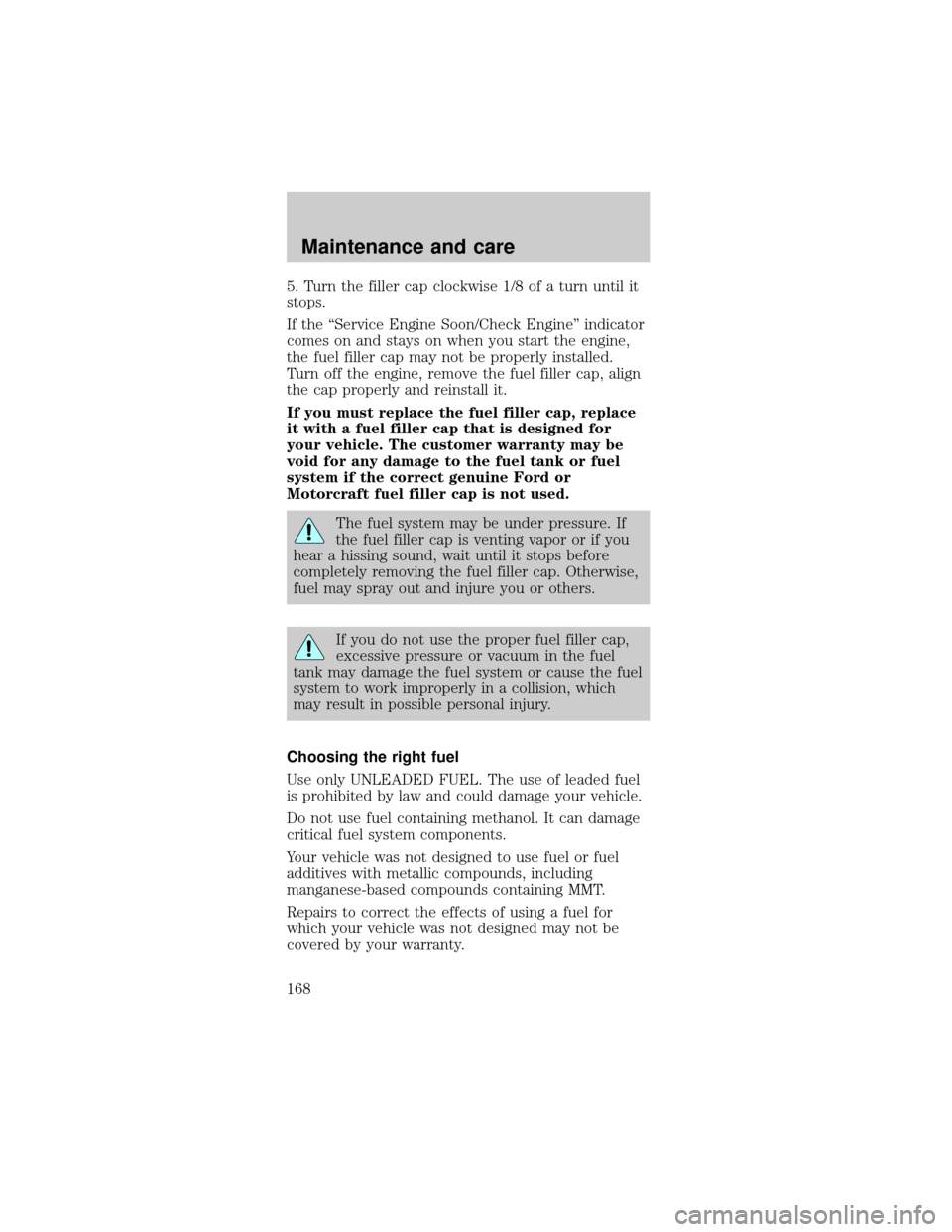1999 FORD TAURUS fuel pressure
[x] Cancel search: fuel pressurePage 158 of 224

If you see any corrosion on the battery or terminals,
remove the cables from the terminals and clean with
a wire brush. You can neutralize the acid with a
solution of baking soda and water.
Batteries normally produce explosive gases
which can cause personal injury. Therefore,
do not allow flames, sparks or lighted substances
to come near the battery. When working near the
battery, always shield your face and protect your
eyes. Always provide proper ventilation.
When lifting a plastic-cased battery,
excessive pressure on the end walls could
cause acid to flow through the vent caps, resulting
in personal injury and/or damage to the vehicle or
battery. Lift the battery with a battery carrier or
with your hands on opposite corners.
Keep batteries out of reach of children.
Batteries contain sulfuric acid. Avoid contact
with skin, eyes or clothing. Shield your eyes when
working near the battery to protect against
possible splashing of acid solution. In case of acid
contact with skin or eyes, flush immediately with
water for a minimum of 15 minutes and get
prompt medical attention. If acid is swallowed, call
a physician immediately.
Because your vehicle's engine is electronically
controlled by a computer, some control conditions
are maintained by power from the battery. When the
battery is disconnected or a new battery is installed,
the engine must relearn its idle and fuel trim
strategy for optimum driveability and performance.
To begin this process:
1. Set your parking brake.
Maintenance and care
158
Page 165 of 224

²The suspension insulation and bumpers will help
prevent vehicle damage. Do not remove these
components from your vehicle when using snow
tires and chains.
WHAT YOU SHOULD KNOW ABOUT
AUTOMOTIVE FUELS
Important safety precautions
Do not overfill the fuel tank. The pressure in
an overfilled tank may cause leakage and
lead to fuel spray and fire.
The fuel system may be under pressure. If
the fuel filler cap is venting vapor or if you
hear a hissing sound, wait until it stops before
completely removing the fuel filler cap. Otherwise,
fuel may spray out and injure you or others.
If you do not use the proper fuel filler cap,
excessive pressure or vacuum in the fuel
tank may damage the fuel system or cause the fuel
system to work improperly in a collision, which
may result in possible personal injury.
Automotive fuels can cause serious injury or
death if misused or mishandled.
Maintenance and care
165
Page 168 of 224

5. Turn the filler cap clockwise 1/8 of a turn until it
stops.
If the ªService Engine Soon/Check Engineº indicator
comes on and stays on when you start the engine,
the fuel filler cap may not be properly installed.
Turn off the engine, remove the fuel filler cap, align
the cap properly and reinstall it.
If you must replace the fuel filler cap, replace
it with a fuel filler cap that is designed for
your vehicle. The customer warranty may be
void for any damage to the fuel tank or fuel
system if the correct genuine Ford or
Motorcraft fuel filler cap is not used.
The fuel system may be under pressure. If
the fuel filler cap is venting vapor or if you
hear a hissing sound, wait until it stops before
completely removing the fuel filler cap. Otherwise,
fuel may spray out and injure you or others.
If you do not use the proper fuel filler cap,
excessive pressure or vacuum in the fuel
tank may damage the fuel system or cause the fuel
system to work improperly in a collision, which
may result in possible personal injury.
Choosing the right fuel
Use only UNLEADED FUEL. The use of leaded fuel
is prohibited by law and could damage your vehicle.
Do not use fuel containing methanol. It can damage
critical fuel system components.
Your vehicle was not designed to use fuel or fuel
additives with metallic compounds, including
manganese-based compounds containing MMT.
Repairs to correct the effects of using a fuel for
which your vehicle was not designed may not be
covered by your warranty.
Maintenance and care
168
Page 174 of 224

²Combine errands and minimize stop-and-go
driving.
Maintenance
²Keep tires properly inflated and use only
recommended size.
²Operating a vehicle with the wheels out of
alignment will reduce fuel economy.
²Use recommended engine oil. Refer toLubricant
Specifications.
²Perform all regularly scheduled maintenance
items. Follow the recommended maintenance
schedule and owner maintenance checks found in
your vehicle Scheduled Maintenance Guide.
Conditions
²Heavily loading a vehicle or towing a trailer may
reduce fuel economy at any speed.
²Carrying unnecessary weight may reduce fuel
economy (approximately 2 km/h [1 mpg] is lost
for every 180 kg [400 lb] of weight carried).
²Adding certain accessories to your vehicle (for
example bug deflectors, rollover/light bars,
running boards, ski/luggage racks) may reduce
fuel economy.
²Using fuel blended with alcohol may lower fuel
economy.
²Fuel economy may decrease with lower
temperatures during the first 12±16 km
(8±10 miles) of driving.
²Driving on flat terrain offers improved fuel
economy as compared to driving on hilly terrain.
²Transmissions give their best fuel economy when
operated in the top cruise gear and with steady
pressure on the gas pedal.
²Close windows for high speed driving.
Maintenance and care
174
Page 185 of 224

Repairing paint chips
Minor scratches or paint damage from road debris
may be repaired with the Ultra Touch Prep and
Finishing Kit (#F7AZ-19K507±BA), touch-up paint
(#ALBZ-19500±XXXXA), or aerosol paint spray
(#ALAZ-19500±XXXXA) from the Ford Car Care
Chemicals line. Please note that the part numbers
(shown as XXXX above) will vary with your vehicle's
specific coloring. Observe the application
instructions on the products.
Remove particles such as bird droppings, tree sap,
insect remains, tar spots, road salt and industrial
fallout immediately.
Cleaning the wheels
Wash with the same detergent as the body of your
vehicle. Do not use acid-based or alcohol-based
wheel cleaners, steel wool, fuel or strong detergents.
Never use abrasives that will damage the finish of
special wheel surfaces. Use a tar remover to remove
grease and tar.
The brushes used in some automatic car washes may
damage the finish on your wheels. Before going to a
car wash, find out if the brushes are abrasive.
Cleaning the engine
In order to identify your vehicle's engine, refer to
Identifying components in the engine
compartmentin the Maintenance and Care chapter.
Engines are more efficient when they are clean
because grease and dirt buildup keep the engine
warmer than normal. When washing:
²Take care when using a power washer to clean
the engine. The high pressure fluid could
penetrate the sealed parts and cause damage.
²Do not spray with cold water to avoid cracking
the engine block or other engine components.
Maintenance and care
185
Page 219 of 224

Jump-starting
your vehicle ............. 135
Keyless entry
system ........................ 66
autolock ................... 69
keypad ..................... 66
locking and
unlocking doors ...... 68
programming
entry code ............... 67
Keys
key in ignition
chime ....................... 11
positions of the
ignition .................... 45
Lamps
autolamp system ..... 17
cargo lamps ............. 17
daytime running
light .......................... 16
headlamps ........ 16,178
headlamps,
flash to pass ............ 17
instrument panel,
dimming ................... 17
interior lamps .. 51,181
replacing bulbs ..... 177
178,179,180,181
Lane change indicator
(see Turn signal) ...... 49
Liftgate ...................... 61
remote release ........ 57
Lights, warning and
indicator ...................... 6
air bag ...................... 11
anti-lock
brakes (ABS) ..... 9,108
anti-theft ................... 9
brake ........................ 10
charging system ...... 10
cruise indicator ....... 10
door ajar .................... 7high beam ................. 6
low coolant ................ 9
low fuel ...................... 8
oil pressure ............. 10
safety belt ................. 7
service engine soon .. 7
speed control .......... 49
turn signal
indicator .................... 6
Load limits ............... 116
GAWR .................... 116
GVWR .................... 116
trailer towing ........ 116
Locks
childproof ................ 55
Lubricant
specifications .... 193,194
Lumbar support,
seats ........................... 76
Mirrors ....................... 52
heated ...................... 55
side view mirrors
(power) ................... 54
Moon roof .................. 52
Motorcraft
parts .................. 170,190
Octane rating .......... 169
Odometer ................... 14
Overdrive ................. 112
Panic alarm feature,
remote entry
system ........................ 62
Parking brake .......... 109
Parts (see
Motorcraft parts) .... 190
Power distribution
box (see Fuses) ...... 129
Power door locks ...... 54
Power steering ........ 110
fluid, checking
and adding ............ 153
Index
219
Page 223 of 224

Item Information
Required fuel-3.0L V6
enginesUnleaded fuel only -
87 octane
Required fuel-3.4L SHO
V8 engineUnleaded fuel only -
91 octane
Fuel tank capacity 60.6L (16 gallons)
Engine oil capacity
(including filter
change)-3.0L V6 Vulcan
engine4.25L (4.5 quarts). Use
Motorcraft 5W30 Super
Premium Motor Oil,
Ford specification
WSS-M2C153-G.
Engine oil capacity
(including filter
change)-3.0L DOHC V6
Duratec engine5.2L (5.5 quarts). Use
Motorcraft 5W30 Super
Premium Motor Oil,
Ford specification
WSS-M2C153-G.
Engine oil capacity
(including filter
change)-3.4L V8 SHO
engine6.1L (6.5 quarts). Use
Motorcraft 5W30 Super
Premium Motor Oil,
Ford specification
WSS-M2C153-G.
Tire size and pressure Refer to Certification
Label. Inflate temporary
spare to 414 kPa (414
kPa (60 psi)).
Hood release Pull handle under the
left side of the
instrument panel.
Coolant capacity (3.0L
V6 Vulcan engine)
111.0L (11.6 quarts)
Coolant capacity (3.0L
DOHC V6 Duratec
engine and 3.4L V8 SHO
engine)
1
10.0L (10.6 quarts)
Filling station information
223